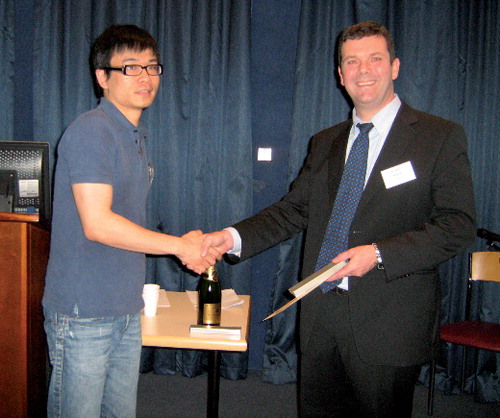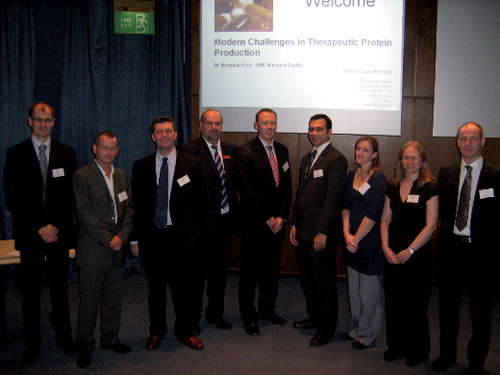Abstract
The Modern Challenges in Therapeutic Protein Production conference hosted 44 delegates from the UK and Germany and was organized by EuroSciCon. The aim of the meeting was to look at the challenges that currently face the production of therapeutic proteins and to attempt to demystify some of the novel approaches and new technologies that are being developed and could have applications in this area. The Chair, Brendan Fish (GlaxoSmithKline, Barnard Castle, UK), gave a detailed introduction to the conference and finished with a summation at the end.
A number of new areas and applications are being adopted in order to improve the development and production of biotherapeutics. The Conference was told that some of the major challenges facing therapeutic protein production were how to decrease the cost, increase the speed and increase the yield of production while maintaining and improving the quality of the product. The development of successful biotherapeutics takes many years and is also a very costly process. Nine talks and four posters were presented along with a question and answer session .
Alison Mason (MedImmune, Cambridge, UK) discussed the strategies and new technologies adopted by MedImmune to streamline and optimize their cell line development and upstream production processes. Mason stated that by adopting these new technologies, it was expected that the original timeline of 6–9 months would be reduced to 4–6 months and that with the use of ClonePix™, more clones could be screened than before. Jenny Thirlway (Eden Biodesign, Liverpool, UK) discussed the approach of Eden Biodesign, which was to reduce cell-line development time while not increasing the cost. Thirlway spoke about the fact that the traditional cell-line development process could easily take over 1 year and that this was mainly due to the time spent on transfections and the selection of cell lines. Thirlway discussed approaches that were being undertaken in order to reduce cell-line development time. The use of transgene amplification (e.g., DHFR and GS), the targeting of ‘hot spots’ (e.g., Flp-In™ and Sympress™), DNA elements, for example, STAR® (Crucell, Leiden, The Netherlands), BI HEX® (Boehringer Ingelheim) and UCOE™ (Millipore), involving the promotion of histone acetylation, preventing/reducing histone deacetylation and controlling higher order structure of chromatin were all discussed. Following on from this, Thirlway discussed cell cloning and selection methods stating that although the traditional method was inexpensive, simple and the most widely used, it was time consuming, had a low throughput and cloning was not guaranteed. However, several automated selected systems are available, for example, Clonepix, which gives a reduction in time (2000 clones in less than 8 weeks compared with 21 weeks), but the drawback is that such technologies are expensive.
The engineering of genes to obtain a specific protein is a recent approach that has been taken in the drive to improve therapeutic protein yield and quality. This process is known as directed evolution and Thomas Waldmann (Sloning BioTechnology GmbH, Puchheim, Germany) discussed Slonomics® technology for the generation of multiple-length variants in synthetic antibody libraries. In comparison to conventional genetic engineering that utilizes single-stranded oligonucleotides, the Slonomics technology uses double-stranded DNA triplets as universal building blocks for the synthesis of any gene sequence. Waldmann went on to explain the construction of a gene library using the Slonomics technology.
Scaling up of protein production & the use & validation of disposable technologies
Gary Pettman (GlaxoSmithKline, Harlow, UK) discussed the scale-up of protein production from animal cells and the challenges that needed to be addressed in order to achieve this. Pettman said that vital to the success of scale-up were a reduction in cost and timeline together with an increase in productivity and quality. As the fermentation process can affect protein yields and quality/integrity, stirred tank reactors, the industry standard for therapeutic protein production, were discussed together with disposable, wave bag and single-use bioreactors. The pros and cons for each were covered. Pettman also commented on the fact that large-scale production gave similar results to the small-scale systems in terms of specific productivity.
A drive for the use of disposables in every stage of the process in the manufacture of biological products is driven, mainly, by both validation and cleaning issues. John Moys (Sartorius Stedim, UK) discussed the use of disposable bioreactors with biosafety and good manufacturing processes compliance being the major considerations. Currently, capacity is at 2000 l and Moys suggested that the perceived goal of capacity would be 5000 l.
Guidelines, requirements & regulations of biological products
The current regulatory requirements and relevant guidelines for both the EMA and the US FDA for biological therapies were discussed by Charles Christy (Covance Laboratories Ltd, Harrogate, UK), with guidance given on the most appropriate analytical methods in order to satisfy these. Christy covered regulatory guidance, key issues, various analytical methods and testing, and discussed what needed to be characterized and tested. Christy demonstrated Covance’s biosafety support of biotechnology drug production, which includes: testing for viruses and other microbes; genetic stability of the cell line; validation of viral clearance, and biopotency lot release and stability testing. In summing up, Christy concluded that a well-planned approach to safety, product characterization, stability and batch release was important in the development of biologics.
Stephen Thompson (S-Cubed Ltd, Oxfordshire, UK) reminded the Conference that US Biologics regulations date back to 1901 following an epidemic of diphtheria that resulted in the tragic death of ten children in St Louis (MO, USA). Thompson discussed the technological advances made in the 1970s and 1980s, which included gene manipulation and recombinant protein production, advances in analysis and manufacturing, and also the development of legislation and guidelines. Thompson then moved on to discuss the current standards for which guidelines are much more readily available with the safety of the product being separated from the safety of the process. Thompson directed the Conference to the relevant guidelines and regulatory requirements for biological therapies.
The Conference also heard from Pete Hughes (Roche Diagnostics Ltd, UK) and from Yitzchak Grant (University College, London, UK). Hughes gave an informed talk on the xCELLigence Systems, which allow for label-free and real-time monitoring of cellular processes. Measurements are able to be made every 15 s for up to several weeks, enabling more-informed decisions with regards to manipulations or treatments to be made. Kinetic responses of cells to manipulation or processing can be made using this technology to inform the user on cell growth, apoptosis and morphological changes. The xCELLigence Systems, therefore, offer advantages over traditional end point assays.
Grant discussed forced degradation studies of proteins formulated by high-throughput techniques, giving a comparison of the benefits to the current limitations of high-throughput approaches for gaining increased understanding of protein behavior. He described how such microplate-based high-throughput screening could be used to investigate protein stability, solubility and process-related conditions and stresses in order to identify problems and allow early intervention to prevent or minimize these.
Conclusion
The overriding conclusion taken away from this conference was that there is a general need for a reduction in costs and timelines, and an increase in productivity and product quality in order to meet the increasing demands for therapeutic biological products. Advances are being made with the use of novel approaches and strategies with the hope that these will help address each of these issues.
Acknowledgements
This meeting was organized by Euroscicon Citation[1]. The 2nd Annual Therapeutic Protein Production event will take place on 10th June 2011 Citation[2].
Financial & competing interests disclosure
The author has no relevant affiliations or financial involvement with any organization or entity with a financial interest in or financial conflict with the subject matter or materials discussed in the manuscript. This includes employment, consultancies, honoraria, stock ownership or options, expert testimony, grants or patents received or pending, or royalties.
No writing assistance was utilized in the production of this manuscript.
Websites
- Euroscicon www.euroscicon.com
- 2nd Annual Therapeutic Protein Production Event www.regonline.co.uk/protein20

